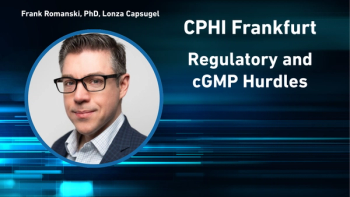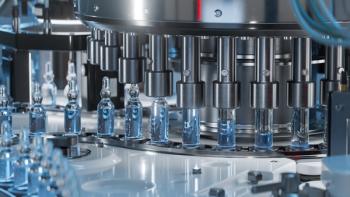
- Pharmaceutical Technology-05-02-2020
- Volume 44
- Issue 5
Good Manufacturing Practices: Aseptic and Sterile Processing
Organizations involved in aseptic and sterile processing activities must make an effort to comply with current good manufacturing practices.
Editor’s Note: This article was published in Pharmaceutical Technology Europe’s May 2020 print issue.
Taking the proper steps to comply with current good manufacturing practices (cGMPs) for aseptic and sterile processing in an efficient and effective manner is necessary for pharmaceutical manufacturing facilities and labs. Pharmaceutical Technology Europe spoke with Ulrich Herber, senior global product specialist manager for Microbial Solutions, Charles River, and Sade Mokuolu, group product compliance manager, Watson-Marlow Fluid Technology Group, about best practices for GMPs in aseptic and sterile manufacturing and in quality control laboratories.
Compliance
PTE: Why is it important for organizations engaged in aseptic/sterile processing activities to practice GMPs?
Herber (Charles River): First and foremost, practicing GMPs ensures a safe, efficacious, and high-quality product that preserves the safety of the end-user: the patient. However, practicing GMPs also ensures that the risk of contaminating the product is reduced or detected and controlled quickly. This ultimately maximizes operational efficiency, eliminates waste, and improves an organization’s bottom line.
Mokuolu (Watson-Marlow): cGMPs are important to ensure that pharmaceutical products meet high quality standards and are safe and effective. As producers of high-value medicinal products, non-compliance with regulations could risk consumers’ health, failing to achieve regulatory approvals, and significant loss of revenue. It is therefore important to not just comply with cGMP regulations, but also be able to demonstrate that you have. GMPs are necessary to demonstrate that there are good control procedures built in during the manufacturing process to prevent errors that cannot be eliminated through quality control of the finished product. Without GMPs, it is impossible to be sure that every unit of medicine is of the same quality as the units of medicine tested in the laboratory.
PTE: How challenging or difficult is it to comply with GMP regulations?
Mokuolu (Watson-Marlow): GMP regulations are well defined and focus essentially on the five P’s: People, processes, procedures, premises, and products. Once there are appropriate controls and ongoing verification of these aspects has been established, it should not be difficult nor challenging to comply to the GMP regulations. The heart of GMP is the establishment of well-written procedures for each operation. These written procedures give us the controls necessary to minimize the chance of mix-ups and errors in manufacturing a product. By carefully following written procedures, it serves to provide evidence of compliance with the GMP regulation, but more importantly, it helps to ensure the consistent quality of drug products. Even though the GMP regulations are well defined, following them precisely can be a challenge for a number of companies, as frequently highlighted in the warning letters (known as 483s) that FDA [the US Food and Drug Administration] publishes regularly.
Herber (Charles River): By and large, GMP regulations are not new to the pharmaceutical industry. Many companies not up to date with current best practices can mistakenly find it overly challenging to comply, but this is not necessarily the case; in fact, it is often easier to exceed minimum requirements very simply.
For example, many new GMP requirements focus on improving the integrity of quality testing data while also reducing subjectivity in analysis and reporting. Many labs are quick to accept the first, most simple option as a solution: applying the ‘four eyes principal.’ Unfortunately, while straightforward to implement, it is not scalable nor is it a true solution. What if the lab performs more tests of the assays requiring two analysts to score the result, and thus, require more time from not one, but two analysts? What if the analysts get different results? What if both analysts get the answer wrong? In many cases, the cause for non-GMP compliance is the test method itself being outdated. These can often be solved by modernizing the traditional test method with rapid or alternative methods and using instrument-based analyses.
Additionally, microbial identification techniques continue to evolve as more information becomes known due to advances in science. Many traditional, bench-based methods for identification, such as gram-stain or phenotypic identification, have been proven to be incapable or error-prone in identifying certain species or groups of closely related species, such as Burkholderia cepacia complex. Many labs feel that they must continue to use outdated techniques because implementing a new technology can be cost-prohibitive and resource intensive, even though outsourcing their identification to a specialized identification lab is a proven, reliable, and more cost-efficient option.
Instruments
PTE: What equipment/instruments does your facility rely on when coordinating aseptic/sterile processing activities?
Herber (Charles River): Utilizing rapid and/or alternative test methods can be a solution that labs can rely on for aseptic/sterile processing. These instruments allow a lab to automate many processes including the assay, the results analysis, and data reporting. Many alternative and rapid methods can replace traditional methods that can pose a risk of non-compliance with GMPs. These include the use of FDA-licensed, cartridge-based LAL [Limulus amebocyte lysate] test methods and instruments to replace antiquated gel-clot methods, or using ATP [adenosine triphosphate] bioluminescence to replace visual turbidity analysis in final product sterility testing. Both of these technologies replace traditional, error-prone assays with automated technology.
Mokuolu (Watson-Marlow): A recent amendment to European guidelines for the manufacture of sterile products, Annex 1 includes the requirement to reduce contamination sources in aseptic processing (1). It details that wherever possible, interventions should be performed aseptically and how the risk of product contamination could be reduced by the use of pre-sterilized closed systems.
Best practices
PTE: How do you suggest other organizations improve/enhance their aseptic/sterile processing activities (specifically, workflow, day-to-day operations, etc.)?
Herber (Charles River): Day-to-day improvements to lab workflows are easily achievable through implementing more automation in the microbiological quality control lab. This speeds the time to result of many assays, which creates higher throughput in the lab’s general operation. It also reduces stress and anxiety on your lab’s staff by reducing the chances of error, the need for retests, and the potential burden of performing investigations for root cause. These alone can greatly improve the overall value, utility, and employee satisfaction in an organization.
Mokuolu (Watson-Marlow): The draft version of Annex 1 has placed a significant emphasis on applying appropriate contamination controls during drug product manufacturing. It describes how contamination risks could be minimized through the use of pre-assembled sterilized equipment.
A further way of enhancing aseptic/sterile processing is to reduce risk through automation. A particular critical unit operation during biomanufacturing is the final filling of the drug product. To this end, equipment such as an automated vial filler and capping unit could be used to provide an aseptic environment and control of process steps.
PTE: Are there any best practices you can recommend for new organizations (e.g., at a start-up), specifically on how to practice and comply with GMPs?
Mokuolu (Watson-Marlow): For new companies, there are a number of ways to comply with GMP regulations. The increasing use of pre-sterilized systems such as single-use assemblies offers a number of advantages that include: no cleaning validation; easy product changeover, particularly for multi-product facilities; and no cross contamination. Additionally, working with a reliable and trusted supply partner with knowledge of GMP regulations means that prevalidated components are easily incorporated into processes and they can also provide effective support and verification of their supply chain.
Herber (Charles River): Startup organizations often mistakenly feel they don’t have the expertise or capacity to implement rapid methods in the beginning and trust the ease and comfort of traditional methods. However, they fail to realize that as a startup, they have the perfect opportunity to innovate and use modern methods in the beginning, rather than try to overcome inertia and reliance on these methods later. Investing the time to gain the knowledge and experience of using the best available methods early will set up startups for success for years down the road. Using rapid, alternative methods not only ensures GMP compliance right out of the gate, but ensures successful business operations by optimizing production, improving product quality, and reducing risks.
Reference
European Commission, EudraLex, Volume 4, EU Guidelines to Good Manufacturing Practice Medicinal Products for Human and Veterinary Use, Annex 1, Manufacture of Sterile Medicinal Products, December 2017.
Article Details
Pharmaceutical Technology Europe
Vol. 32, No. 5
May 2020
Pages: 28-29
Citation
When referring to this article, please cite it as L. Lavelle, “Good Manufacturing Practices: Aseptic and Sterile Processing,” Pharmaceutical Technology Europe 32 (5) 2020.
Articles in this issue
over 5 years ago
Modern Drug Manufacturing Key to COVID-19 Responseover 5 years ago
How Fast Is Too Fast?over 5 years ago
Starting a Career in the Bio/Pharmaceutical Industryover 5 years ago
Can We Teach an Old Drug New Tricks?over 5 years ago
Small-Volume Conversion Kit for Bathless Dissolution Testersover 5 years ago
Inline High Shear Mixersover 5 years ago
Pre-Packed Columnsover 5 years ago
Laser-Marked Smart ContainersNewsletter
Get the essential updates shaping the future of pharma manufacturing and compliance—subscribe today to Pharmaceutical Technology and never miss a breakthrough.




